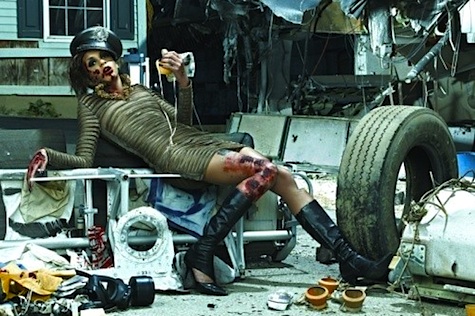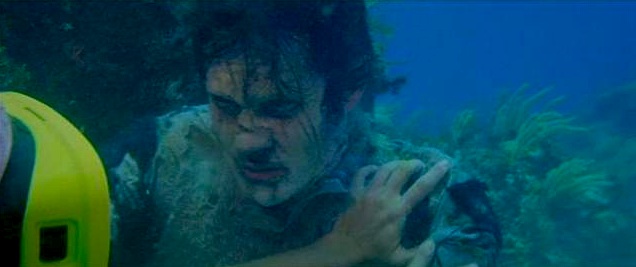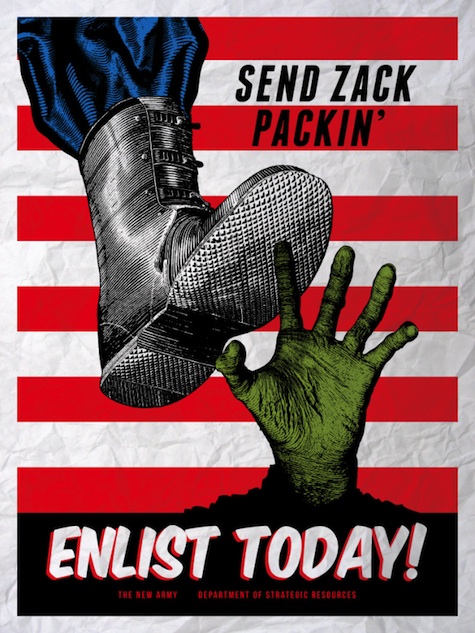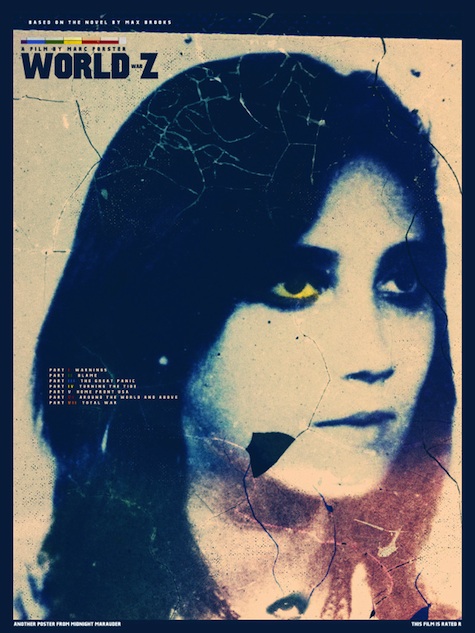As the movie adaptation of Max Brooks’s blockbuster novel approaches—it’s finally due out in U.S. theaters this Friday—I’m keeping an open mind. The movie might be great, or it might be just mediocre, and there’s a decent chance it’ll stink on ice. But the one thing I’m not expecting is for it to be very much like the book on which it’s based.
The complaint I’ve been hearing most about the trailer is how the filmmakers have changed the zombies from shambling, Romero-esque undead hordes to an unstoppable swarm of speedy power-zombies. Personally, I’m not much bothered by that change—faster zombies are probably a better fit for the movie they’ve produced, which looks like a pretty conventional action movie.
It’s true that in writing World War Z, Brooks was inspired by George Romero’s zombies—but he was also inspired (perhaps even more directly) by the work of author/historian Studs Terkel.
Terkel’s oral histories—and particularly his Pulitzer Prize-winning The Good War: An Oral History of World War II—provided the interview-style format that, for me, is the heart and soul of World War Z. What sets the book apart is its structure and its scope, as the unnamed narrator gently prods his subjects to share their experiences, recounting their lives before, during, and after the war.
In the upcoming movie, Brad Pitt plays Gerry Lane, a UN employee trying to save the world (and his immediate family) from the international zombie scourge. Gerry Lane does not exist in the book—there is no single, main protagonist in the book, and while that choice may make it easier to spin a simpler, unfragmented narrative, it also means losing the richness of Brooks’s vision: the many varied, competing, complementary voices and perspectives that lend an added depth and realness to the fiction.
Taking its cue from Terkel’s work, World War Z relates—but does not limit itself to—the triumphs of the war: the battles won, the individual tales of bravery and resilience, figures who inspired when spirits were at their lowest, moments of hope in the face of unfathomable horror and darkness. It is also a record of what was lost in the struggle: the mistakes and hideous compromises that were made, the times when our humanity failed, when common decency broke down in the face of terror, and when survival came at a horrific price. While celebrating the courage and strength of humanity, World War Z also captures the devastating scope of loss and sacrifice on an international scale by weaving together the different stories, disparate worldviews and opinions, each story intimate and yet larger than itself.
Without the multiplicity of perspectives, it’s hard to see the difference between the premise of this new movie and a dozen or more other disaster films like The Day After Tomorrow or 2012, and hey—that’s not the end of the world (even when it is. See: 2012). Sometimes a big, blockbuster-y apocalyptic action thriller can be pretty (even perversely) fun—and maybe this film will incorporate some of the moral complexity and raise some of the same troubling questions as the novel did, and maybe it won’t. But while we’re waiting, let’s take a look back on a few of the characters and stories that helped make the book such a tour de force. It’s possible that some of them have found their way into the movie, in some form or other—but if you haven’t read World War Z lately (or at all), they’re certainly worth (re)visiting. Light spoilers for the book below:
1 & 2: Colonel Christina Eliopolis and “Mets Fan”
Even among the many thrilling vignettes which comprise World War Z, this action-packed trek through the zombie-filled swamps of Louisiana is a masterpiece. Col. Eliopolis of the Civil Air Patrol crash-lands in the bayou, and makes her way to safety with the help of a tough-talking civilian Sky Watcher…who may or may not be a figment of her imagination. As a narrator, Eliopolis may be unreliable, but while the details of her experience may be in doubt due to trauma, shock, and psychological damage, the essential truth and emotional impact of the story remains—the ordeal of a soldier, drawing on her last reserves of strength and sanity in order to make it back to safety, whether the help and guidance she received was real or imagined.
3 & 4: Kondo Tatsumi and Sensei Tomonaga Ijiro
Before the war, Kondo Tatsumi was a sullen, socially awkward teenager who preferred to live his life almost entirely online. Finally forced to deal with reality when the internet stopped functioning, Tatsumi escapes from his zombie-infested apartment building by climbing floor-to-floor, salvaging a deadly WWII-era katana from an elderly (undead) neighbor along the way. He eventually encounters Tomonaga Ijiro, a hibakusha, or surviving victim of the bombings of Hiroshima and Nagasaki. Blinded by the atomic bomb blast in 1945, Sensei Ijiro lived as a gardener before fleeing into nature to avoid being seen as a burden as the undead began arriving. Instead of dying in the wild, however, he becomes a master of locating and dispatching the undead, using only his gardening shovel.
Tatsumi joins Ijiro in his quest to rid Japan of zombies: two unlikely warrior monks patiently hacking away with sword and shovel. Their stories, which start out separately before dovetailing, are equally riveting, and together they underscore how high tech modernity can benefit from the traditions and simplicity of the past, as intergenerational respect paves the way toward progress (a running theme throughout the book, in many places).
5: T. Sean Collins
A grizzled mercenary who worked private security at the outset of the Zombie War, Collins relates the unfortunate tale of his ridiculously wealthy unnamed employer, who sets up a compound on Long Island and invites the rich and famous to weather the zombie crisis under his roof, partying with their fellow celebrities while the rest of New York slides into chaos. He also insists on broadcasting a live feed of the drama and debauchery inside the mansion to the outside world, and the terrified populace soon comes calling, a panicked mob climbing the walls and tearing down the fortifications. The scene plays out like some bizarre mash-up of The Great Gatsby, the French Revolution, and bad slapstick—horror bordering on farce; Collins looks on with disgust and makes his exit, leaving his wealthy clients to fend (rather poorly) for themselves. Collins is a fun character—a gritty, amoral tough guy who finds himself in a situation that’s utterly, completely absurd—and Brooks gets in some nice satirical digs at reality TV and bogus celebrities as he paints a picture of society gone completely haywire.

6: Captain Chen of the Admiral Zheng He
Driven to desertion by the Chinese Government’s disastrous policies and refusal to adapt to the realities of zombie warfare, Captain Chen and the crew of the nuclear submarine Admiral Zheng He take desperate measures in order to preserve some vestige of Chinese civilization. After loading the Zheng with provisions and smuggling the families of the crew on board, the submarine goes rogue, diving to relative safety to wait out the crisis. Danger remains ever-present, however, as the seas swarm with reanimated dead and the Zheng is stalked by another sub from the Chinese fleet (which may or may not be helmed by Captain Chen’s son).

The story of the Admiral Zheng He is fascinating from start to finish, from the tortured, idealistic patriotism of the Captain to the climactic ending, in which the acting Communist government is violently destroyed in order to save the remaining population. It’s a suspenseful thrill ride (with plenty of taut family drama), all contained within a single chapter of the book.
7: Jesika Hendricks
In Jesika’s story, we get the perspective of a child survivor of the Zombie War. She and her parents fled north when the U.S. shut down and closed itself off, leaving the population east of the Rocky Mountains to fend for itself. Because the living dead freeze solid in cold temperatures, many people packed up and headed toward Canada in order to escape the coming hordes…but they were completely unprepared for life in the wild. Illness and starvation ran rampant as all sense of community and civilization broke down. People became violent, almost feral, and eventually resorted to cannibalism.
As Jesika tells it, there’s no lurid sensationalism to the story—just sadness and grim acceptance at the things she’s seen, the darkness and panic of that time. It captures the horror and desperation of the situation with restraint and respect, as Jesika (now a naturalized Canadian citizen) works as part of the Wilderness Restoration Project, slowly and painstakingly clearing the land of debris, abandoned vehicles, and corpses left behind by those who didn’t survive the desperate northern exodus.
8: Terry Knox
The first and only Australian commander of the International Space Station, Knox stayed behind with several other crew members to operate the ISS after the rest of the team evacuated (when it became clear that no replacement astronauts would be sent, due to the fast-growing crisis on Earth). Remaining in space with dwindling supplies and resources, Knox and the others dedicated themselves to the maintenance of the ISS and the satellites most vital to the war effort—communications, navigation, etc.
Knox’s story plays out like “Space Oddity” in reverse, as he and the other astronauts monitor the events unfolding at home and do everything they can to try to aid their fellow humans, with no expectation of rescue or relief. This is one of my favorite survival vignettes in all of World War Z—Knox is such a charming, courageous, likeable character, and it’s hard not to love a story that could be summed up using the tagline “incredibly inspiring selfless heroics…in space!”
9: Roy Elliot
A famous Hollywood director before the war, Elliot decided to use his filmmaking skills to combat the syndrome known as ADS (officially “Asymptomatic Demise Syndrome,” sometimes referred to as “Apocalyptic Despair Syndrome”). People were dying at an alarming rate, suffering from a psychological disorder brought on by hopelessness and trauma; physically healthy, they would simply stop functioning, go to sleep and never wake up again. After learning of ADS and its crippling effects, Elliot frantically entreated the government to let him help, to no avail—so he enlisted his wife and son and began filming on his own. Using a digital video camera, they shot 96 hours of footage in the town of Claremont, CA, as three hundred college students made a heroic stand and successfully fought off thousands of zombies. Roy Elliot edited the footage into a film and began screening it at various camps and shelters, getting no immediate response. In the coming weeks, however, the film was recognized as a hugely valuable tool in raising morale and fending off ADS, and Elliot went on to direct a powerful series of propaganda films intended to raise the spirits of beleaguered Americans, helping to instill in them a newfound sense of hope.

I love this nod to the importance of artists and the essential necessity of stories to humanity, and the idea that people need an escape from reality (especially when reality seems unrelentingly grim). Roy Elliot’s story clearly owes a debt to director Frank Capra and perhaps a bit to Sullivan’s Travels, and maybe it’s just a coincidence, but I couldn’t help but think about the fact that Brooks’s parents once co-starred in To Be or Not to Be, a movie about entertainers who use their talents to change history during World War II, which participates in the same tradition on a couple of different levels.
10: Darnell Hackworth (and Maisey the Dachshund)
Hackworth runs a retirement home for dogs who served in the U.S. Army’s K-9 Corps, and details the vital role that canines played in the war effort, sniffing out the undead, acting as decoys, etc. He also speaks of the close (and occasionally tragic) bond that formed between handlers and their canine partners, and the pathos is further driven home by the appearance of Maisey, an elderly miniature dachshund, who curls up on Hackworth’s lap as he discusses the sacrifices and bravery of the dogs, like Maisey, who helped clear the country from “Zack.” It may sound overly sentimental, but Hackworth’s impassioned interview certainly does not come off that way in the text (and for the record, we here at Tor.com love our real-life war dogs—particularly Sergeant Stubby, the most decorated dog of World War I). All I’m saying is that no matter how good or bad the movie turns out to be, everything’s better with warrior dachshunds in the trenches.
We’ll know in a few days whether any of these characters or storylines get a nod in the new film—or if maybe the writers have introduced some intriguing new angles of their own into the history of the Zombie War—but in the meantime, I highly recommend checking out the original book. And if you have your own set of favorite characters or stories you’d like to see in the big-screen version, let’s discuss in the comments…
Poster images by Masked Marauder and Tracie Ching via Blurppy.
World War Z concept art by Corlen Kruger.
Bridget McGovern is the managing editor of Tor.com. She is also a little dubious about the fact that the movie is set in her hometown (Philadelphia), but filmed in Glasgow (Not Philadelphia). Scotland, I love you, but a haggis is not a cheesesteak.










